Ancient civilisations have always fascinated us. The culture, beliefs and traditions of a people have always fascinated us. Their infrastructure, trade, the weapons they used, their governing hierarchy and foreign and religious influences are  still relevant to us today as we try to understand our origins. All this helps us understand the ancient world. That is why any museum, for that matter, is important. It gives us insights into a different era or the way of life of a particular civilisation through the display of ancient Artefacts.
still relevant to us today as we try to understand our origins. All this helps us understand the ancient world. That is why any museum, for that matter, is important. It gives us insights into a different era or the way of life of a particular civilisation through the display of ancient Artefacts.
Located at Sir Marcus Fernando Mawatha, the National Museum is one of the most famous Colonial buildings in the country. Its Architect James. G. Smithers (1833-1910) was the Chief Government Architect from 1867-1883. The National Museum was his most outstanding work and stands as one of Southeast Asia’s finest achievements in 19th-century colonial architecture. It is a two-floor building and it was opened in 1877. The whole idea belonged to its founder, Sir William Henry Gregory, the British Governor of Ceylon (1816 – 1892). Arasi Marikar Wapchie Marikar carried out the construction of the Museum.
Director General, Department of National Museums, Sanuja Kasthuriarachchi, said that the galleries at the Colombo National Museum are second to none and that from the moment you enter the premises to the moment you leave, the
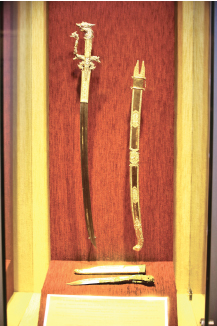
Kasthane
experience is something special and rewarding. The learning experience is indeed tremendous. The galleries feature old, original and priceless artefacts. The collections are ancient and priceless. There is definitely something special and alluring there. According to her, there certainly is wealth here at the National Museum when it comes to the collections. “I feel that there are certain museums who try and introduce technology to the museum to compensate for a lack of original artefacts,” said Kasthuriarachchi.
Digitally innovative museums
The Louvre Museum is world famous. We are told it is one of the world’s largest and most visited museums. We are also told that the Louvre has become one of the most forward-thinking and digitally innovative museums. Even without technology, it can hold its own.
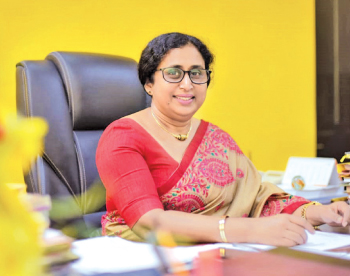
Sanuja Kasthuriarachchi.
Pictures by Thilak Perera
Kasthuriarachchi pointed out that some people who visit our National Museum may think it is not as good as the Louvre Museum or a museum in Thailand. “We have precious collections here. There is no vacuum here that we need to fill by introducing technology. However, I feel that technology is important for more information. So I want to tell the public not to have any doubts about the quality of our museum.”
She added that the artefacts on display have been obtained through excavations at sites. They are originals. When it comes to the Museum experience, the National Museum, as said before, is second to none. “What we show at the National Museum is our crème de la crème. We also have collections in our stores. They are open for research. But sometimes, these artefacts are also displayed. From time to time, we change our exhibitions. We need to keep in mind that there is sensitivity to lighting. So we change conditions. Under the department, there are 11 museums, and artefacts are distributed to these museums,” she said.
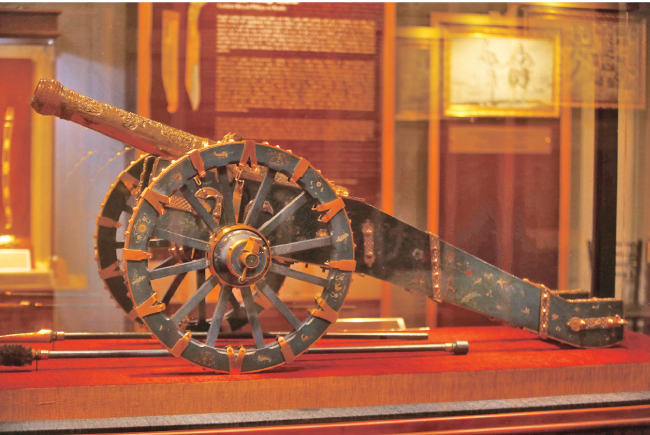
Lewke Cannon
However, the cost of the exhibition is something that needs to be taken into consideration. And because of the financial crisis, our yearly provisions are minimal. “We are always interested in holding exhibitions, but then again, so many matters need to be taken into account because of the financial crisis. We have one section called the Ethnology Division. There, we have the archaeological object collection and obtained these collections through archaeological excavations. Then, we have the Anthropological Division. There, we have the folk society/community collection and arts and crafts. Then, we also have the Zoology and Botany Division. There, we have fauna and flora collections. We also have the Geology Division. This features the prehistoric geological specimen collection. So we have some excellent collections,” she added.
Enthusiastic crowd
The government of the Netherlands decided to return to Sri Lanka cultural artefacts seized during the colonial period. They
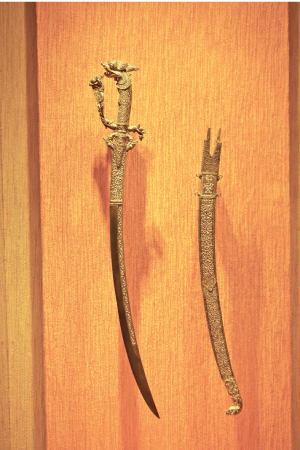
Kasthane
are the famous Lewke Cannon, a Gold Kastane (ceremonial sword), a Sinhalese knife with a crystal, a Silver Kastane and two guns. These were kept at the Mahanuwara Palace and were taken by the Dutch. The exhibition was held last December, and these artefacts can be seen now. Here, Kasthuriarachchi pointed out that this is a two-way street. First, a country needs to request that their artefacts be returned. The country that took the artefacts must also be willing to return them.
“I feel that there is still a lot of enthusiasm for people coming to this museum. There is an interest in finding our shared identity and tracing our roots. We at the museum are pleased and satisfied with the numbers coming in. Students, like those in international schools, are also interested in pursuing an internship there. These youth are very technologically savvy. So, I feel that today, there is an interest amongst the youth in discovering our common heritage. So there is that eagerness,” explained Kasthuriarachchi.
There are also programmes at the Museum to attract schoolchildren by making the programmes relevant to their syllabus. They go to schools, hold these programmes, and do it internally. “There are activities to further their knowledge. These children are very enthusiastic. On Children’s Day, we hold programmes at the Museum and invite children to look at the artefacts and get their perspectives and views. So there are many educational programmes and a lot of interaction. We also did mobile exhibitions in distant places in the past,” she said.
“Museums Must Evolve”
MMCA Sri Lanka Chief Curator Sharmini Pereira offers another perspective on the broader context of museums.
“Being successful today as a museum involves looking at your audience as much as your collection, exhibition, and learning programs. It’s crucial to consider audiences from the point of view of local, national, and international perspectives. The Colombo National Museum has a fascinating collection, but like all museums, it probably only shows a small percentage. It would be great to see them doing more with their collection displays and directing attention to more audience engagement. Inviting contemporary artists to work with their incredible collection and the building would no doubt start to make the past more relevant to us today,” said Pereira.
She points out that there are over 100 museums in the country, indicating how widespread the culture of museums is on an island of our size.
“At the MMCA Sri Lanka, we have tried to reinvigorate the idea of the museum by curating a space of learning and engagement that focuses on research-led exhibitions. In our view, this is where quality resides. By curating exhibitions that are not commercially led and that look at the history of artworks, we are creating a much-needed museum of modern and contemporary art that looks at the country’s art production with the depth it deserves. When people step inside the MMCA Sri Lanka, they experience something they haven’t seen before in the country. Everything from the design of the shows, the art on display, the trilingual labels, and the interactions lends itself to creating larger, more critically engaged audiences. We have a long way to go, but if anything, it propels us into the future. We have been able to attract and sustain many visitors, not just for a few weeks but for the last five years. Our average daily visits have doubled since we first opened, suggesting that we must be doing something right. But moreover, there is a public demand for a museum of modern and contemporary art,” explained Pereira.
If museums want to be relevant, they must adopt technology in their day-to-day practices. At the MMCA Sri Lanka, they think about the audience experience starting before someone enters the physical space. A visitor will likely have looked online at their website and their IG and FB accounts in preparation for visiting.
“They will, ideally, revert to social media when they leave to share posts about their visits. Digital interaction with audiences is vital for museums in terms of staying connected. That said, today’s technology is no different from the past in its ability to mechanise tasks more efficiently. The MMCA Sri Lanka, for example, is looking at writing our didactics and press releases using ChatGPT, freeing up exhibition teams to do other tasks. During the pandemic, many museums realised that their digital marketing teams were ahead of their curatorial teams in their ability to use digital platforms to generate content. To this end, the Zoom era has probably generated more content than we have time or headspace to process. Which raises the question of archiving, for which technology also provides a raft of means to carry out complex archiving exercises that were once performed manually,” pointed out Pereira.
Treasures Returned
In a landmark act of cultural repatriation, three precious artifacts have made their long-awaited journey back to Sri Lanka. Following an agreement with the Dutch government, these treasures now stand to enrich their rightful home.
- Lewke Cannon
The small cannon known as Lewke’s Cannon is cast in bronze, gilded, engraved, and richly decorated with silver, gold, and gemstones. It carries a shield resembling Kandyan royal emblems (lion with sun and moon) and is embellished with typical Kandyan motifs such as liyawel, kalpavrukshaya, and narilata. The accompanying gun carriage is made of tropical wood. The Cannon was made in a foundry in the Dutch Republic or Batavia, probably as a gift for or on the orders of the King of Kandy. The cannon’s technology, shape, and decoration are both Kandyan and European in style. This cannon is known as Lewke’s Cannon because Lewke Disava is mentioned as the donor in the Sinhala inscription on the Cannon. The inscription indicates that Lewke Disava later added decoration onto the cannon and gifted it to King Sri Vijaya Rajasinghe (1739- 1747) between 15 April 1745 and 15 April 1746.
- Kandyan Kasthane
The highly ornamented Kandyan Kasthane or sabre has a hilt made of solid gold, shaped with a lion head (Sinha) and two female deities (Saraswati and Sri Lakshmi). It is decorated with 136 diamonds and 13 rubies. The Wooden Scabbard is coated in gold foil and decorated with floral designs. Research indicates that this Kasthane was made in the “Rankadu Pattale” (Golden Sword Workshop), one of the four royal workshops (Pattal Hatara) of the Kandyan Kingdom. The Kasthane, known as Magul Kaduwa, was one of the five auspicious objects of the Kings. It is believed to be the personal property of King Kirti Sri Rajasinha (1747- 1782). This is the only lion-headed royal sword ever found in Sri Lanka.
- Kandyan Silver Kasthane
The highly ornate Kandyan Silver Kasthane, or sabre, has a hilt made of silver along with the ornamentation of the blade and scabbard. The Pommel is a lion head with a prominent conical crest. The standing figure on the knuckle guard is identified as Goddess Sri Lakshmi or Naridevi. The languet is long and triangular with a silver overlay showing embossed floral ornament. The wooden scabbard is entirely covered by silver foil with embossed traditional motifs. The chape is curved with decorative floral work resembling a hamsa’s head at the end. Its shape and ornaments are typical for Kasthanes from the Kandyan kingdom in the eighteenth century. This Kasthane was made in the royal workshop of the Kandyan Kingdom and was probably meant for a member of the Kandyan aristocracy.
The Royal Seat
This Royal seat was donated to King Wimaladharamasuriya II by Dutch governor Thomas van Rhee, who ruled the coastal area of Ceylon in 1693. Six kings used the Royal Seat after the death of King Wimaladharamasuriya II. King Sri Wickrama Rajasinghe, the last king of Sri Lanka, finally used it. After the King was captured by English soldiers in 1815, the sword of the state, along with its belt, footstool, sceptre, and this royal seat, was sent to England. Later, this seat was returned to Sri Lanka by King George V through the Duke of Gloucester in 1934. The sword of the state, with its belt and sceptre, along with others, was sent back by King Edward VIII in 1936.
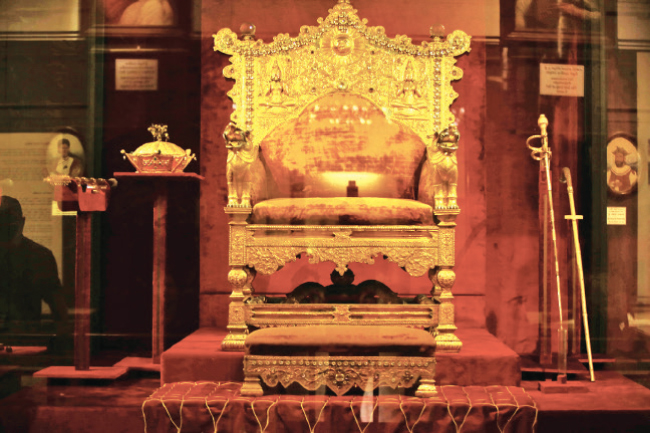
Royal Seat
An Architect’s Guide to Designing Museums
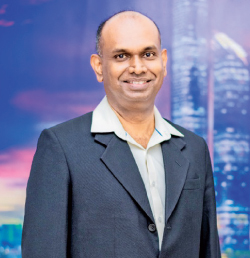
Archt. Nirodha Gunadasa
Nirodha Gunadasa is a chartered architect renowned for designing landmark and monumental buildings locally and internationally. The Daily News spoke to him to gain insight into how an architect approaches the design of a museum.
“As an architect designing a museum, I prioritise creating an immersive and engaging environment for visitors. I would start by understanding the theme and purpose of the museum. The architecture should reflect and enhance the intended atmosphere, whether it’s art, history, science, or any other theme. This could involve incorporating elements such as natural light, materials, colours, and spatial layout to evoke visitors’ desired emotions and reactions,” said Gunadasa.
He added that the museum’s layout should facilitate a logical flow for visitors, guiding them through the exhibits in a cohesive manner. “I would carefully consider the spatial arrangement, ensuring there are both open areas for contemplation and more intimate spaces for focused viewing. Interactive exhibits and multimedia installations could also be strategically placed to enhance engagement and learning.”
The arrangement of artefacts is crucial. It should be thoughtful and purposeful, telling a coherent narrative or conveying a specific message. An architect should work closely with curators to determine the best way to display and organise the exhibits, considering factors such as chronology, thematic connections, and cultural significance.
“Lighting plays a crucial role in enhancing the visual experience of a museum. I employ a combination of natural and artificial lighting to highlight key artefacts, create focal points and set the overall mood. Adjustable lighting fixtures would allow for flexibility in showcasing exhibits and accommodating varying lighting needs. Overall, my approach would be to create a museum environment that showcases artefacts and fosters exploration, learning, and emotional connection for visitors. Through thoughtful design and attention to detail, I aim to craft a space that leaves a lasting impression and encourages repeat visits.”
He explained that the allure of museums lies in their ability to transport us through time, space, and culture, allowing us to connect with the past, explore the present, and imagine the future. They serve as repositories of knowledge, art, and history, offering a glimpse into different worlds and perspectives. The fascination with museums is deeply rooted in our innate curiosity and desire to learn, discover, and be inspired.
“Ultimately, museums have the power to shape the minds and hearts of young people, instilling in them a sense of belonging, pride, and appreciation for their cultural heritage and national identity. By creating engaging and educational experiences, museums play a vital role in shaping informed and empowered citizens committed to preserving and celebrating their country’s rich history and heritage,” he added.

Expanding Opportunities: The Modern Museum Era
In terms of employment opportunities, the expansion and modernisation of museums present a wide range of roles in curatorial work, conservation, education, digital media, and administration. Additionally, establishing new museums in Colombo and other parts of Sri Lanka could stimulate economic growth by creating jobs, attracting tourism, and promoting cultural exchange.







